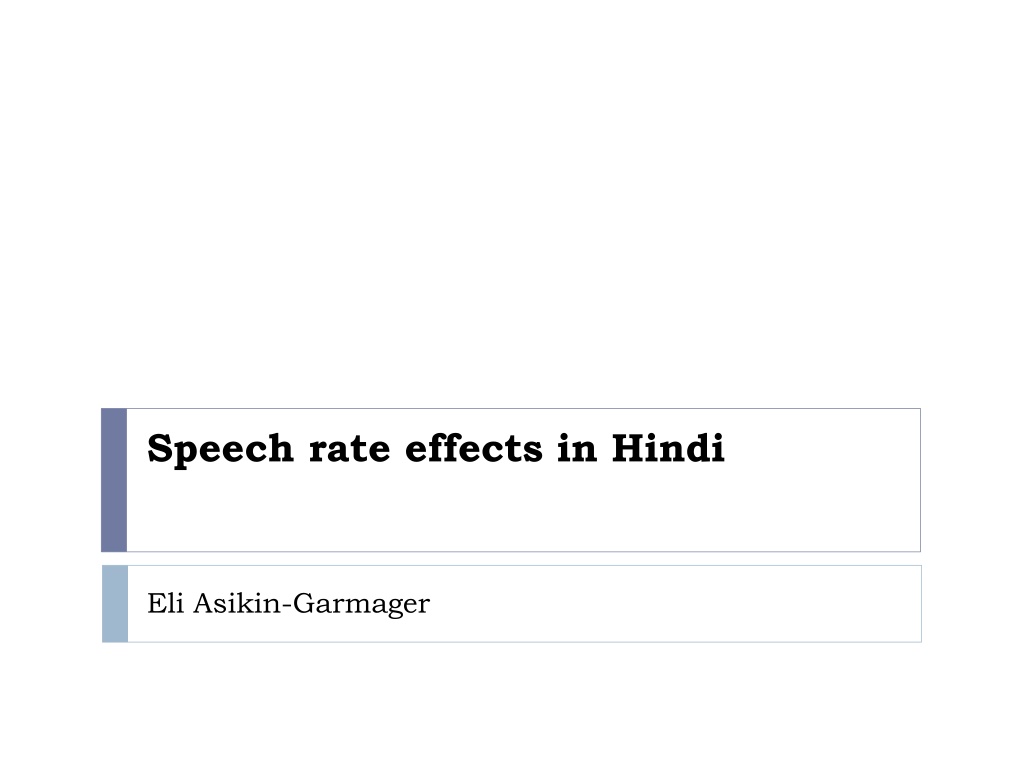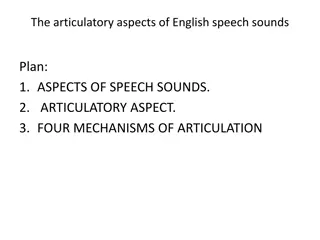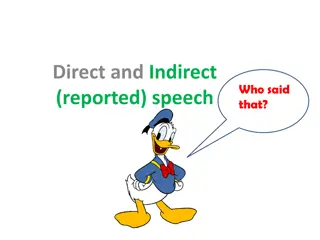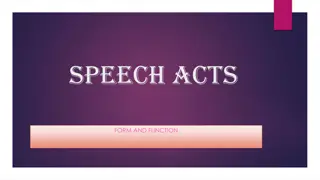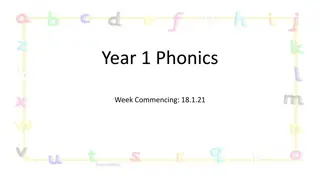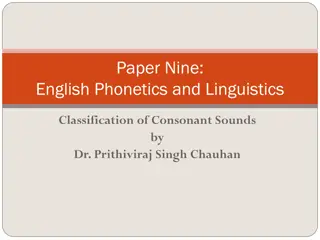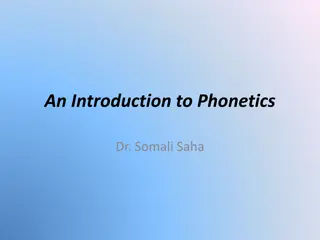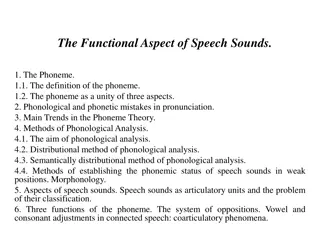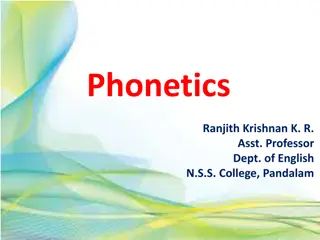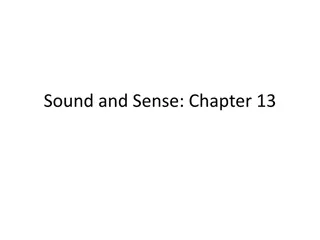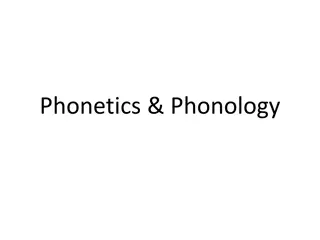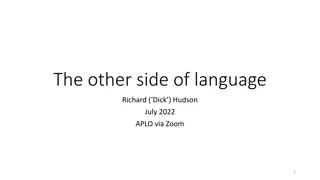Exploring Speech Rate Effects in Hindi Sounds System for Linguistics Research
Conducted by a first-year PhD student in Linguistics, this pre-dissertation research project focuses on the sounds system of Hindi speakers in Southeast/East Asia, particularly Indonesia. The research delves into sound production, perception, mental representation, and perceptual cues influenced by speech rate. Various contrasts in Hindi stop consonants are analyzed alongside visual representations like spectrograms to deepen the understanding of speech patterns and language structures.
Download Presentation

Please find below an Image/Link to download the presentation.
The content on the website is provided AS IS for your information and personal use only. It may not be sold, licensed, or shared on other websites without obtaining consent from the author. Download presentation by click this link. If you encounter any issues during the download, it is possible that the publisher has removed the file from their server.
E N D
Presentation Transcript
Speech rate effects in Hindi Eli Asikin-Garmager
Who am I? PhD Linguistics student 1st(of 2) pre-dissertation research projects Research: Languages of Southeast/East Asia, particularly Indonesia Language documentation Sounds systems Grammar (syntax)
Broad nature of the project (1) How are (certain types of) sounds produced by Hindi speakers? (2) How do listeners perceive these sounds? (3) How do speakers represent these sounds in their minds? (4) How do certain perceptual cues change as a function of speech rate?
a simple English sentence Dan can t get Tom to buy Pat s dog. Dan can t get Tom to buy Pat s dog. Voiced Voiceless ( Aspirated ) p t k b d g Stop (consonant) = is airflow completely stopped momentarily? Voiced = are the vocal fold vibrating during production? Aspirated = is there a puff of air following the release of closure?
Hindi: 4-way stop contrast 1 of 13 languages in a UCLA database of 451 languages with voiced aspirated stop consonants Stop category Voiceless Unaspirated Voiceless Aspirated Voiced, Unaspirated Voiced Aspirated Bilabial pal take care of bal hair p al knife blade b al forehead Dental t al beat t al plate d al lentil d al knife Retroflex al postpone al wood shop al branch al shield Velar kan ear gan song k an mine g an bundle Place of articulation (POA) Hindi Stops (Ladefoged & Johnson 2011:155)
What is a spectrogram? Visual representation of speech x-axis = time y-axis = frequency gray scale (darkness) = intensity waveform spectrogram
ta:p - voiceless, unaspirated short positive-lag VOT (+) VOT V O W E L Release of closure beginning of vowel
ta:b - voiceless, aspirated (+) VOT aspiration (puff of air) V O W E L Release of oral closure Beginning of vowel
ba:l - voiced, unaspirated (-)VOT V O W E L Onset of voicing Release Beginning of vowel (stop closure) of oral closure
Lead & Lag Time b a:r - voiced, aspirated Lead Time Lag Time (voicing) (aspiration) (-)VOT (+)VOT V O W E L Onset of voicing Stop release Vowel onset
Methods Participants convenience sample 5 native Hindi speakers living in the US Materials 47 target words (randomized) (all POA, all stop categories), 2 repetitions each word-initial, monosyllabic words with same vowel 3 speech rates ( citation , slow , fast ) citation = word list slow / fast = words embedded in a sentence distractor items
Methods, cont Procedures recordings made in sound booth in EPB each participant performed the same 3 tasks in the same order, (citation, slow, fast) taking a break between tasks recordings then output to Pratt - program used for analyzing waveforms & spectrograms Measurements (in milliseconds) word duration lead time ( voicing /before release of closure) lag time (after release of closure/sometimes aspiration )
Lead & Lag Time (dependent variables) b a:r - voiced, aspirated Lead Time Lag Time (voicing) (aspiration) (-)VOT (+)VOT V O W E L Onset of voicing Stop release Vowel onset
Methods Variables Independent: speech rate (citation, slow, fast) Dependent: lead and lag times
Primary (stats) questions Primary questions: 1. Was there a statistically significant difference in word duration for the three speech rates? 2. Were the effects found on lead and lag time statistically significant? 3. Question #1/2, but for each individual speaker -------------------- 4. Were there any statistically significant differences for the stops based on place of articulation? 5. Were the lead/lag times statistically significant for the (4) different stop categories?
Selected References Beckman, J. (2012). Privative laryngeal features and passive voicing: Evidence from Hindi. Paper presented at The Manchester Phonology Meeting, May 26. Beckman, J., Helgason, P., McMurray, B., & Ringen, C. (2011). Rate effects on Swedish VOT: Evidence for phonological overspecification. Journal of Phonetics, 39(1), 39-49. Berkson, K. H. (2012). Caputuring breathy voice: Durational measures of oral stops in Marathi. Kansas Working Papers in Linguistics, 33, 27-46. Boersma, P., & D. Weenink. (2014). Praat: doing phonetics by computer [Computer program]. Version 5.3.63, http://www.praat.org/ Davis, K. (1994). Stop voicing in Hindi. Journal of Phonetics, 22, 177-193. Dutta, I. (2007). Four-way stop contrasts in Hindi: An acoustic study of voicing, fundamental frequency and spectral tilt. Ph.D. dissertation, University of Illinois at Urbana-Champaign. Kagaya, R. & Hirose, H. (1975). Fiberoptic electromyographic and acoustic analyses of Hindi stop consonants. Annual Bulletin, Research Institute of Logopedics and Phoniatrics, University of Tokyo, 9, 27-46. Kessinger, R. H., & Blumstein, S. E. (1997). Effects of speaking rate on voice-onset time in Thai, French, and English. Journal of Phonetics, 25, 143-168. Ladefoged, P., & Johnson, K. (2011). A course in phonetics (6th ed.). Boston: Wadsworth. Lisker, L., & Abramson, A. S. (1964). A cross-language study of voicing in initial stops: Acoustical measurements. Word, 20, 384-422. Mikuteit, S., & Reetz, H. (2007). Caught in the ACT: The timing of aspiration and voicing in East Bengali. Language and Speech, 50(2), 247-277.
